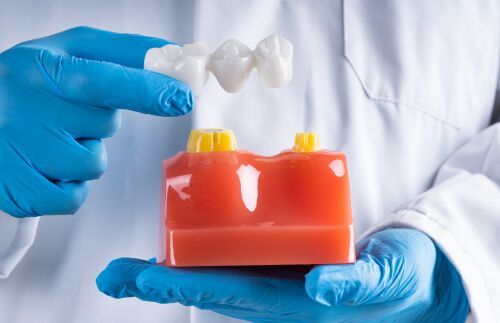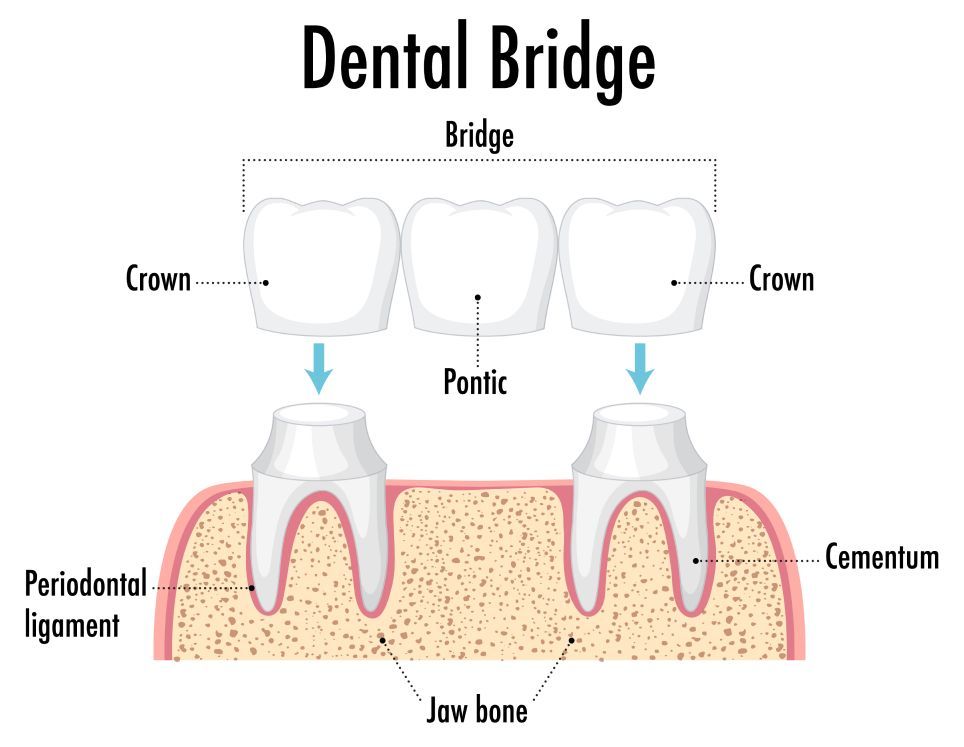How Does a Dental Bridge Work?

Dental bridges are a well-established solution in restorative dentistry, yet many patients are unaware of how they function or the range of options available. Unlike more commonly discussed treatments like implants, dental bridges offer a unique method of replacing missing teeth by leveraging the strength of surrounding teeth.
This blog will explore the intricacies of how dental bridges work, answering questions that are often overlooked. By understanding the process, types, and benefits of dental bridges, patients can make informed decisions about their oral health that are tailored to their specific needs.
What is a Dental Bridge?
A dental bridge is a custom-made prosthetic device designed to replace one or more missing teeth by bridging the gap left in the dental arch. It consists of one or more artificial teeth, known as pontics, which are anchored in place by crowns attached to the natural teeth or implants on either side of the gap. These supporting teeth, referred to as abutment teeth, provide the necessary stability for the bridge.
Dental bridges not only restore the aesthetics of a patient’s smile but also improve functionality, allowing for better chewing and speaking, while preventing remaining teeth from shifting out of alignment. This restorative solution is particularly beneficial for patients who prefer a less invasive alternative to dental implants, offering both cosmetic and functional improvements in oral health.

Traditional Bridges
Traditional bridges are the most common type of dental bridge and have been used successfully for many years. They consist of one or more pontics (artificial teeth) that are held in place by dental crowns cemented onto the abutment teeth, which are the natural teeth adjacent to the missing tooth or teeth. This type of bridge is highly durable and is ideal for patients with strong, healthy teeth on either side of the gap. However, because the process involves preparing the abutment teeth by removing some of their enamel to accommodate the crowns, it is somewhat invasive. Despite this, traditional bridges offer excellent strength and aesthetics, making them a popular choice for restoring the function and appearance of missing teeth.
Cantilever Bridges
Cantilever bridges are similar to traditional bridges but differ in that they are anchored by a crown on only one abutment tooth rather than two. This type of bridge is used when there is only one adjacent tooth next to the gap, making it a viable option when traditional bridges are not suitable. However, cantilever bridges are generally used in areas of the mouth that do not endure significant biting forces, such as the front teeth. The reason for this is that relying on a single abutment tooth can put additional strain on that tooth, potentially leading to complications over time. Despite these considerations, cantilever bridges can be an effective solution for replacing missing teeth in specific situations.
Maryland Bridges
Maryland bridges, also known as resin-bonded bridges, are a more conservative option compared to traditional bridges. Instead of using crowns on the abutment teeth, Maryland bridges use a metal or porcelain framework with wings that are bonded to the back of the adjacent teeth. This bonding process requires minimal alteration to the surrounding teeth, preserving more of their natural structure. Maryland bridges are commonly used for replacing front teeth due to their conservative nature and the less significant biting forces in this area. While they offer a less invasive solution, Maryland bridges may not be as strong as traditional or cantilever bridges, particularly in areas where significant biting force is applied.
Implant-Supported Bridges
Implant-supported bridges are an advanced option that offers superior stability and longevity. Instead of relying on crowns on natural teeth, this type of bridge is anchored by dental implants that are surgically placed into the jawbone. Implant-supported bridges are an excellent solution for patients missing multiple teeth, particularly when the adjacent teeth are not strong enough to support a traditional bridge. This type of bridge can replace several teeth in a row and provides a secure, long-lasting result. The procedure for an implant-supported bridge is more involved, requiring surgery to place the implants and a longer healing time, but the outcome is often more durable and feels more like natural teeth.
Each type of dental bridge has its specific uses, advantages, and limitations, making it essential for patients to consult with their dentist to determine the best option based on their individual needs and oral health condition.
Initial Assessment
The dental bridge process begins with an initial consultation and assessment. During this visit, the dentist evaluates the patient’s overall oral health, focusing on the teeth adjacent to the missing tooth or teeth. The dentist will take X-rays or digital scans to assess the health of the abutment teeth and the surrounding bone structure. This step is crucial to determine whether the patient is a good candidate for a dental bridge and to identify the most appropriate type of bridge for their specific situation. The dentist will also discuss the patient’s expectations, the treatment plan, and any potential risks or alternatives.
Preparation of Abutment Teeth
Once the initial assessment is complete and the treatment plan is agreed upon, the next step involves preparing the abutment teeth. For traditional and cantilever bridges, this preparation involves reshaping these teeth by removing a portion of enamel to create space for the crowns that will hold the bridge in place. This step is done under local anesthesia to ensure patient comfort. For Maryland bridges, minimal preparation is required, as only a small amount of enamel may need to be removed to help the bonding process. In the case of implant-supported bridges, this step would involve placing the dental implants, which requires a surgical procedure.
Fitting of the Temporary Bridge
After the abutment teeth are prepared, the dentist will take impressions of the patient’s teeth. These impressions are sent to a dental laboratory where the custom bridge is fabricated. In the meantime, the patient will receive a temporary bridge to protect the exposed abutment teeth and maintain the appearance of their smile. The temporary bridge also helps the patient get accustomed to the feel of a bridge while waiting for the permanent one.
Placement of the Permanent Bridge
Once the permanent bridge is ready, the patient returns to the dentist for the final fitting. The temporary bridge is removed, and the new custom-made bridge is carefully fitted. The dentist will make any necessary adjustments to ensure a comfortable bite and proper alignment. Once satisfied with the fit, the bridge is cemented into place using a strong dental adhesive. The dentist will then provide instructions on how to care for the new bridge and schedule follow-up visits to monitor its condition and ensure it is functioning well.
Comparing Dental Bridges and Implants
When deciding between dental bridges and implants, it’s essential to consider various factors to determine which option is best for your specific needs. Dental bridges are less invasive, as they don’t require surgery and offer a quicker solution for replacing missing teeth. However, they rely on the adjacent teeth for support, which means those teeth need to be in good condition. Implants, on the other hand, involve surgically placing a titanium post into the jawbone, offering a more permanent and durable solution. Here are some key differences:
- Durability: Implants are generally more durable and long-lasting.
- Invasiveness: Bridges are less invasive, with no surgery required.
- Bone Preservation: Implants help preserve the jawbone, while bridges do not.
- Support: Bridges rely on adjacent teeth, whereas implants stand alone.
- Cost: Bridges are typically less expensive upfront, while implants may have higher initial costs but are more cost-effective in the long run.
Considering these factors, patients can work with their dentist to choose the option that best suits their dental and financial situation.
Caring for Your Dental Bridge
Proper care is essential to ensure the longevity and effectiveness of your dental bridge. With the right maintenance, a dental bridge can last many years, preserving both function and aesthetics. Here are some key care tips:
- Brushing: Brush your teeth at least twice a day with fluoride toothpaste, paying special attention to the area around the bridge.
- Flossing: Use floss or interdental brushes to clean between the teeth and under the bridge, preventing plaque buildup.
- Avoid Hard Foods: Refrain from chewing on hard foods or objects that could damage the bridge.
- Regular Dental Visits: Schedule regular check-ups and cleanings with your dentist to monitor the condition of your bridge and overall oral health.
By following these care guidelines, you can help ensure your dental bridge remains in excellent condition for years to come.
Conclusion
If gum recession does occur, several treatment options are available depending on the severity. Mild cases might be managed with improved oral hygiene and more frequent dental cleanings to remove plaque and tartar. For more advanced cases, your dentist might recommend procedures such as scaling and root planing, which involves deep cleaning the roots of the teeth to remove bacterial buildup. In cases where significant gum tissue has been lost, a gum graft may be necessary to restore the gums and protect the tooth roots. It’s important to address gum recession early to prevent more serious dental issues and to maintain the effectiveness of your Invisalign treatment.

